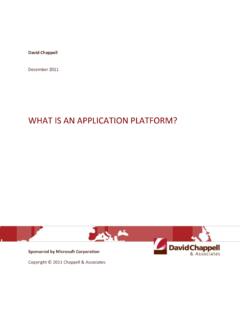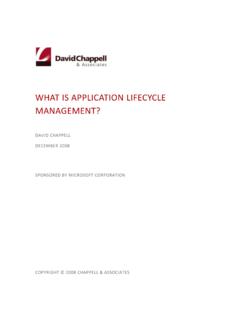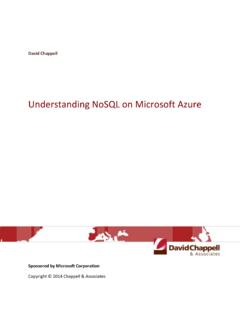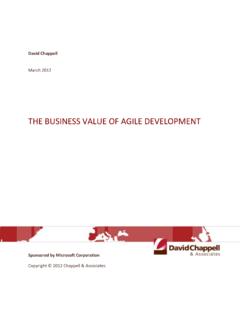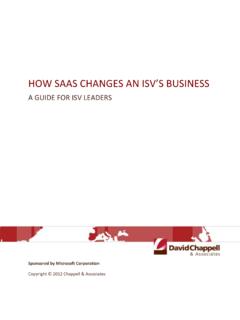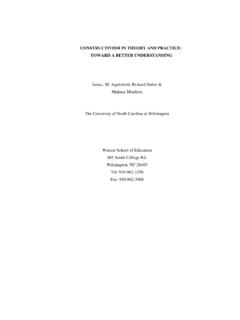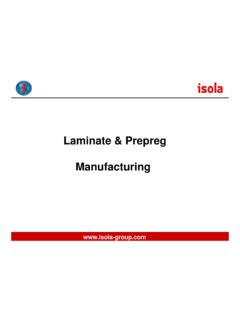Transcription of Understanding Enterprise RPA - David Chappell
1 David Chappell Understanding Enterprise RPA The Blue Prism Example Sponsored by Blue Prism Copyright 2016 Chappell & Associates 2 Contents Introducing Enterprise RPA .. 3 What is Enterprise RPA? ..3 Characteristics of Enterprise RPA Technologies ..5 Implementing Enterprise RPA: The Blue Prism 6 Maintainability and Reuse ..6 Robot Creation ..7 Development process ..8 Scalability ..9 Reliability ..10 Access Control and Auditing ..11 Management ..12 Ecosystem ..13 Conclusion .. 14 About the Author .. 14 3 Introducing Enterprise RPA Robotic process automation (RPA) is a technology for automating business processes. Because RPA can be applied to a range of scenarios, including many that are beyond the reach of traditional integration projects, this approach has fired the imagination of many people. And because RPA can lower costs, increase flexibility, and improve process accuracy, as well as help business and IT work together more effectively, it s a hot technology that s being adopted by many organizations in many different industries.
2 The core idea of RPA is simple. Rather than have people interact with applications, RPA instead uses software robots that drive application user interfaces in the same way. (Don t be confused by the terminology these aren t robots in the usual sense of the word. Still, the name RPA has become established in the industry, as has the notion of software robots.) Figure 1 shows how this looks. Figure 1: RPA uses software robots rather than people to carry out business processes. Still, there s some confusion. The term RPA is applied to a broad set of offerings, ranging from simple screen-scraping products to much more complex technologies. The goal of this paper is to bring some clarity to this area. Specifically, we ll focus on Enterprise RPA, describing what it is and what s required to do it well. As a concrete example of an Enterprise RPA product, we ll use Blue Prism. What is Enterprise RPA?
3 To understand the idea of Enterprise RPA, start by thinking more broadly about the technology options for automating a business process . For business processes that rely on multiple applications, one approach is to rely on application programming interface (APIs) exposed by the applications the process uses. API-based integration is what s used in products that provide Enterprise application integration (EAI), for example, and it s the right solution in many cases. Yet automating a business process with RPA is often a better choice. As Figure 1 showed, RPA automates a business process solely through application user interfaces, which makes this approach simpler, faster, and less expensive than API-based automation. And because RPA can work with applications that don t expose APIs, it can be used with a broader range of existing software. 4 To decide whether RPA or the API-based approach is better , you need to consider two main factors: What kind of business process is being automated?
4 How complex and important is it? process automation that requires connecting two ERP systems when organizations merge is a multifaceted, business-critical operation. Automating a process that reads spreadsheets and feeds their data into an invoicing system is simpler to implement and probably less important to the business. Who will do the work required to implement the process automation? API-based automation the EAI approach is largely the province of IT, as it requires very technical people. RPA, however, is commonly done by business people, although sometimes in concert with IT. Given these two dimensions for making the decision, Figure 2 summarizes the approaches your organization might take to automating business processes. Figure 2: The best approach for automating a business process depends on what kind of process it is and who will implement the automation. In this figure, the horizontal axis represents the complexity and importance of an automated process .
5 The vertical axis shows the technical knowledge of the people who will implement that automated process , ranging from non-technical business users at the bottom to very technical IT staff at the top. As the figure shows, automated business processes can be grouped into three categories, each addressed by a different style of process automation technology: In the upper right are complex, important processes automated using API-based automation. The implementation is done largely by IT. In the lower left are simple, less important processes for which automation can be done entirely by the business people who carry out these processes. Many RPA tools target this kind of process , often providing a 5 record button that makes it fast and easy for users to create automation scripts. The organization s IT staff commonly has no knowledge of these, since they re created and controlled entirely by the business.
6 The technologies that address this part of the problem space provide simple RPA. The area in the middle is the province of Enterprise RPA. The processes that fit here aren t as important or as complex as those in the upper right, but they re also not as simple as those in the lower left. To do them well, IT and business people need to work together. As the figure suggests, a substantial number of business processes fall into this category. All three approaches API-based automation, simple RPA, and Enterprise RPA have value, and so it s important to make good choices about which one to use in each situation. Business processes that are a good fit for Enterprise RPA tend to have these characteristics: The automated process needs to be scalable, reliable, secure, and manageable. In other words, the automation must be built on a solid technical foundation; your IT organization needs to be comfortable with it.
7 Automating the process has business value, but typically not enough to justify the cost of API-based automation. As a result, the process would never rise to the top of your IT organization s to-do list. Even though IT must be involved, control of the automated processes needs to remain with the business. This might be because the process changes frequently, and involving IT in every change would be too slow, or for some other reason. Yet once IT has laid the groundwork, business people must be able to create and change these process automations on their own. Characteristics of Enterprise RPA Technologies What do Enterprise RPA technologies look like? To a great extent, these products have the core characteristics that organizations look for in all Enterprise software. Those characteristics include the following: An approach that allows maintainability and reuse of software robots and the components they re built from.
8 An approach to robot creation that balances the need for fast implementation with high-performance execution. A development process that s both repeatable and reliable. Support for scalability, because Enterprise RPA solutions don t run robots on user desktops. Support for reliability, letting robots run unattended on servers. The ability to ensure access control and auditing, letting an organization be sure that its robots are doing the right things. Effective management of robots, such as the ability to control them in groups rather than one at a time. An ecosystem that includes partners, training, and the other things enterprises need to succeed with RPA. What follows uses Blue Prism to illustrate how these characteristics can be provided by an Enterprise RPA solution. 6 Implementing Enterprise RPA: The Blue Prism Example Blue Prism is an Enterprise RPA company headquartered in the United Kingdom.
9 Its product, also called Blue Prism, was an early entry in this space, and it s a market leader today. (In fact, Blue Prism coined the term robotic process automation in 2012.) Blue Prism is used today by financial services firms, organizations that do business processing outsourcing (BPO), mobile phone companies, and others. Maintainability and Reuse Simple RPA products commonly create scripts that directly access applications. This approach works well for desktop automation scenarios. For Enterprise RPA, however, it raises some challenges. For example, when an application s user interface changes, all of the scripts that use that application must change as well. This can make maintenance challenging how does an organization even find every script that needs to be changed? Also, wrapping all of the logic of an automated business process into a script makes it hard to reuse that logic, even when multiple processes use the same applications in similar ways.
10 As an Enterprise RPA product, Blue Prism takes a different approach. Rather than creating scripts, software robots are built using Blue Prism-defined business objects and processes. Figure 3 shows how this approach compares with simple RPA Figure 3: While simple RPA uses scripts, Blue Prism creates robots using business objects driven by processes. In a Blue Prism robot, business objects communicate with application user interfaces, while the robot s process contains the logic that drives this communication. This approach can make life easier for the people who create and modify robots for a couple of reasons: Adapting to changes in application user interfaces is easier. Because all interaction with applications is done by business objects, changes in a user interface require changing only the business objects that talk to this application. This is simpler than finding and changing all of the scripts that work with the changed application.
